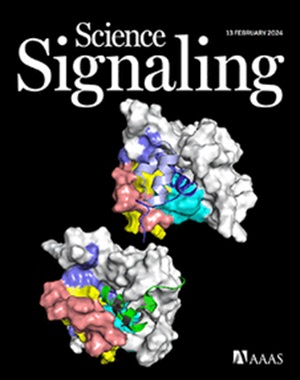IRF1与ISGF3或GAF协同在巨噬细胞中形成先天免疫新生增强因子。
IF 6.7
1区 生物学
Q1 BIOCHEMISTRY & MOLECULAR BIOLOGY
引用次数: 0
摘要
暴露于免疫刺激下的巨噬细胞重新编程其表观基因组以改变其后续功能。暴露于细菌脂多糖(LPS)会引起广泛的核小体重塑和数千种新生增强剂的形成。我们剖析了干扰素调节因子(irf)网络诱导染色质打开和新生增强子形成的调控逻辑。我们发现lps激活的IRF3通过激活I型干扰素(IFN)诱导的ISGF3间接介导了新生增强子的形成。然而,ISGF3通常需要与IRF1合作,特别是在染色质不易获得的地方。在这些位置,染色质的初始打开需要IRF1, ISGF3扩展可及性并促进H3K4me1的沉积,标记平衡增强子。由于IRF1的表达依赖于转录因子NF-κB,而NF-κB在感染细胞中被激活,而不是在旁观者细胞中被激活,因此irf调节的增强因子需要激活先天免疫信号网络的IRF3和NF-κB分支。然而,通常由T细胞产生的II型IFN (IFN-γ)也可能通过STAT1同二聚体GAF诱导IRF1表达。我们发现,在IFN-γ刺激下,IRF1也负责打开无法进入的染色质位点,然后GAF可以利用这些位点形成新生增强子。总之,我们的研究结果揭示了IRF1-ISGF3或IRF1-GAF的组合逻辑门如何限制暴露于病原体或IFN-γ分泌T细胞的巨噬细胞的免疫表观基因组记忆形成,而不是短暂暴露于I型IFN的旁观者巨噬细胞。本文章由计算机程序翻译,如有差异,请以英文原文为准。
IRF1 cooperates with ISGF3 or GAF to form innate immune de novo enhancers in macrophages
Macrophages exposed to immune stimuli reprogram their epigenomes to alter their subsequent functions. Exposure to bacterial lipopolysaccharide (LPS) causes widespread nucleosome remodeling and the formation of thousands of de novo enhancers. We dissected the regulatory logic by which the network of interferon regulatory factors (IRFs) induces the opening of chromatin and the formation of de novo enhancers. We found that LPS-activated IRF3 mediated de novo enhancer formation indirectly by activating the type I interferon (IFN)–induced ISGF3. However, ISGF3 was generally needed to collaborate with IRF1, particularly where chromatin was less accessible. At these locations, IRF1 was required for the initial opening of chromatin, with ISGF3 extending accessibility and promoting the deposition of H3K4me1, marking poised enhancers. Because IRF1 expression depends on the transcription factor NF-κB, which is activated in infected but not bystander cells, IRF-regulated enhancers required activation of both the IRF3 and NF-κB branches of the innate immune signaling network. However, type II IFN (IFN-γ), which is typically produced by T cells, may also induce IRF1 expression through the STAT1 homodimer GAF. We showed that, upon IFN-γ stimulation, IRF1 was also responsible for opening inaccessible chromatin sites that could then be exploited by GAF to form de novo enhancers. Together, our results reveal how combinatorial logic gates of IRF1-ISGF3 or IRF1-GAF restrict immune epigenomic memory formation to macrophages exposed to pathogens or IFN-γ–secreting T cells but not bystander macrophages exposed transiently to type I IFN.
求助全文
通过发布文献求助,成功后即可免费获取论文全文。
去求助
来源期刊

Science Signaling
BIOCHEMISTRY & MOLECULAR BIOLOGY-CELL BIOLOGY
CiteScore
9.50
自引率
0.00%
发文量
148
审稿时长
3-8 weeks
期刊介绍:
"Science Signaling" is a reputable, peer-reviewed journal dedicated to the exploration of cell communication mechanisms, offering a comprehensive view of the intricate processes that govern cellular regulation. This journal, published weekly online by the American Association for the Advancement of Science (AAAS), is a go-to resource for the latest research in cell signaling and its various facets.
The journal's scope encompasses a broad range of topics, including the study of signaling networks, synthetic biology, systems biology, and the application of these findings in drug discovery. It also delves into the computational and modeling aspects of regulatory pathways, providing insights into how cells communicate and respond to their environment.
In addition to publishing full-length articles that report on groundbreaking research, "Science Signaling" also features reviews that synthesize current knowledge in the field, focus articles that highlight specific areas of interest, and editor-written highlights that draw attention to particularly significant studies. This mix of content ensures that the journal serves as a valuable resource for both researchers and professionals looking to stay abreast of the latest advancements in cell communication science.
 求助内容:
求助内容: 应助结果提醒方式:
应助结果提醒方式:


